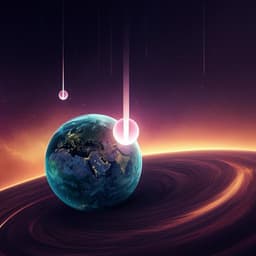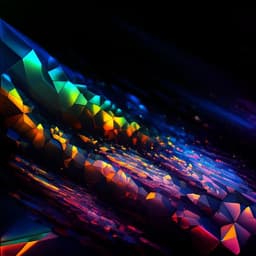
Physics
Experimental observation of violent relaxation
M. C. Braidotti, M. Lovisetto, et al.
A groundbreaking optical experiment has directly observed the phenomenon of violent relaxation, a process crucial to understanding the formation of structures in the universe. Conducted by a team of researchers including Maria Chiara Braidotti and her colleagues, this study offers a fresh perspective on how galaxy formation can be mirrored through controlled optical dynamics.
~3 min • Beginner • English
Introduction
Structures of the observable Universe, such as galaxies and globular clusters, appear macroscopically stationary but are not at thermodynamic equilibrium: their stellar velocity distributions are non-Maxwellian and the collisional relaxation times exceed their ages. Lynden-Bell (1967) proposed violent relaxation as a mechanism forming out-of-equilibrium quasi-stationary states on timescales much shorter than those for thermal equilibrium. This mechanism is generic to Hamiltonian systems with long-range interactions and bears similarity to Landau damping in plasmas, although violent relaxation has remained elusive experimentally due to noise in candidate systems (e.g., cold atoms) and excessively long astrophysical timescales. Numerical studies using Vlasov-Poisson/N-body models support the theory but offer limited experimental guidance. Here, the authors report the experimental observation of violent relaxation in an optical platform with self-induced long-range interactions, enabling direct observation of phase mixing in a time-varying potential and relaxation to a quasi-stationary state. Through the Schrödinger-Poisson/Newton-Schrödinger to Vlasov-Poisson correspondence, the observed optical dynamics serve as an analogue for (dark matter) galaxy formation via violent relaxation.
Literature Review
The study builds on foundational work: Chandrasekhar’s estimates of relaxation times in stellar systems and Lynden-Bell’s theory of violent relaxation for long-range Hamiltonian systems. Analogous processes like Landau damping have been observed in laboratory and space plasmas. Numerical investigations of gravitational collapse and violent relaxation via Vlasov-Poisson and N-body simulations corroborate the theoretical framework. Optical analogues of the Newton–Schrödinger equation have been used to emulate gravitational phenomena (e.g., gravitational lensing, boson star dynamics), and the Schrödinger-Poisson to Vlasov-Poisson correspondence justifies using wave-based optical experiments to model classical dark matter dynamics. Prior optical studies often focused on soliton formation in nonlocal media; here, the focus shifts to the semi-classical background (analogue galaxy) and its relaxation dynamics.
Methodology
Theory and analogy: The evolution of self-gravitating dark matter in 3D is described by the Newton–Schrödinger equations (wavefunction ψ, gravitational potential φ). In the semi-classical limit (ħ/m small), violent relaxation leads to a quasi-stationary state comprising an oscillating solitonic core and a broader classical halo consistent with the Vlasov-Poisson limit. The optical analogue uses paraxial beam propagation in a thermally focusing, nonlocal nonlinear medium governed by i ∂z E + ∇⊥² E + k0 β Δn E + i α E = 0, with Δn determined by a Poisson equation ∇⊥² Δn = |E|². Identifying z as time t yields the same structure as Schrödinger-Poisson in 2D (with logarithmic potential), allowing 2D observation of violent relaxation. Key diagnostic quantities: a spatially dependent chemical potential density U(r,z) = |∇E|²/(2 k0) − k0 Δn(r,z) (kinetic minus potential energy densities), and the Wigner transform F(r⊥, k⊥, z) to probe phase-space mixing.
Experimental setup: A CW laser (λ = 532 nm) is split into reference and target beams. The target beam (Gaussian, waist s = 350 μm at input) is sent through three aligned lead-doped glass slabs (each L0 = 100 mm; total length L = 300 mm; height D = 5 mm; width W = 40 mm). Material parameters: background refractive index n ≈ 1.8, thermal conductivity κ = 0.7 W m⁻¹ K⁻¹, absorption coefficient α = 1 m⁻¹, thermo-optic coefficient β = 2.2 × 10⁻⁵ K⁻¹ (effective β obtained by fit is 1.6× manufacturer value), transmission T = 0.92. Input powers P ∈ [0.2, 5.5] W in 0.25 W steps. The output field (intensity and phase) at z = L is measured via off-axis digital holography by interfering with the reference beam and recording on a CMOS camera. Because only the output is directly accessible, the evolution along z is mapped by varying input power P, exploiting a regime where the nonlinear dynamics scale such that changing P corresponds to sampling different effective propagation distances z at fixed L. A dynamical scale zdyn = 5 η κ/(α β P) is used to rescale z; thus, varying P scans the normalized propagation coordinate z/zdyn. The chosen beam size and powers ensure operation in the semi-classical regime (soliton size small compared to the overall beam size) to emphasize the broad background (analogue galaxy) rather than a soliton-dominated regime.
Data analysis: From the reconstructed complex field at the output, the chemical potential density distribution U/U0 is computed (U0 a normalization constant) to detect changes driven by the evolving potential V = −k0 Δn. The Wigner distribution F(r⊥, k⊥) is evaluated (y = 0, ky = 0 lineouts shown) to visualize phase-space mixing (twisting and filamentation). Numerical simulations: Paraxial wave simulations (Eq. 2) reproduce the experiment, and separate N-body simulations of self-gravitating particles with matched parameters (via the established correspondence) provide a particle analogue of the observed optical galaxy. Simulations were implemented in Matlab/C as detailed in Supplementary Notes.
Key Findings
- First experimental observation of violent relaxation in a controlled, table-top optical system with long-range (nonlocal thermal) interactions.
- Beam evolution with increasing input power P (0.2–5.5 W) shows initial self-focusing collapse followed by stabilization into a central, oscillating high-intensity solitonic core surrounded by a broad, lower-amplitude background (analogue galaxy). This quasi-stationary configuration persists despite ongoing oscillations.
- Chemical potential density: The normalized distribution U/U0 exhibits strongest variation and mixing in the low-power regime (approximately 0.5–3 W), coinciding with the largest change in potential V, identifying this interval as the violent relaxation phase. After P ≈ 3 W, two persistent structures emerge in U/U0: a low-U component associated with the central solitonic core and a higher-U component associated with outer rings. Beyond this, U/U0 becomes nearly constant (quasi-stationary) even though the intensity profile continues evolving.
- Phase-space mixing: Wigner distributions show progressive twisting and the development of filamentary structures with increasing P—hallmarks of phase-space mixing accompanying violent relaxation.
- Agreement across modalities: Good qualitative agreement between experiment and numerical paraxial simulations, and consistency with an equivalent N-body simulation that maps experimental parameters to a particle dark-matter galaxy, reinforcing the Schrödinger-Poisson to Vlasov-Poisson correspondence.
- Nonlocality averts catastrophic collapse, enabling observation of the relaxation dynamics and the emergence of the quasi-stationary state.
- The chosen semi-classical regime maximizes the background (analogue galaxy) relative to a soliton-dominated state, aligning with theoretical expectations for violent relaxation.
Discussion
The study directly addresses the long-standing challenge of observing violent relaxation by implementing an optical analogue governed by equations formally equivalent to Schrödinger-Poisson/Vlasov-Poisson dynamics. The concurrent observation of (i) strong variation in the effective potential and chemical potential density and (ii) pronounced phase-space mixing (twisting and filamentation in the Wigner distribution) satisfies the key criteria for violent relaxation. The subsequent approach to a quasi-stationary state—central solitonic core plus extended background—matches semi-classical predictions and astrophysical analogies of galaxy formation, where chemical potential can evolve slowly while morphology continues to change. The agreement between experiments, optical simulations, and matched N-body simulations substantiates the optical–gravitational analogy and demonstrates that violent relaxation is a robust dynamical process in systems with long-range interactions, beyond astrophysical contexts.
Conclusion
The work provides the first experimental evidence of violent relaxation, leveraging a nonlocal, thermo-optical nonlinear medium to emulate long-range gravitational-like interactions. By tracking the evolution of chemical potential density and phase-space structure, the experiment captures the hallmarks of violent relaxation and the formation of a quasi-stationary state. The established correspondence to dark-matter dynamics (Schrödinger-Poisson to Vlasov-Poisson) allows a direct mapping to N-body systems and suggests that such optical platforms can serve as accessible laboratories for analogue galaxy and plasma evolution. Future research can exploit this platform to systematically tune nonlocal potentials, dimensionality, and initial conditions, probe different relaxation pathways, and explore regimes relevant to both classical and quantum dark matter analogues.
Limitations
- Measurement access is limited to the sample output plane; the internal propagation dynamics are inferred via power-to-distance mapping, which relies on scaling assumptions valid in the chosen regime.
- The optical system is 2D transverse with a logarithmic effective potential, whereas astrophysical gravity is 3D with an inverse-square potential; despite the shared mechanism, quantitative differences are expected.
- The semi-classical operating regime is chosen to maximize background formation rather than produce an ideal stationary soliton; the solitonic core is oscillatory and not the primary focus.
- Absorption is present but argued to have little effect on the observed dynamics; residual dissipation or experimental noise may still influence fine details.
- Temporal evolution is inferred by scanning input power rather than direct time-resolved propagation within the medium; this equivalence holds under specified conditions and may not capture all dynamical subtleties.
Related Publications
Explore these studies to deepen your understanding of the subject.







